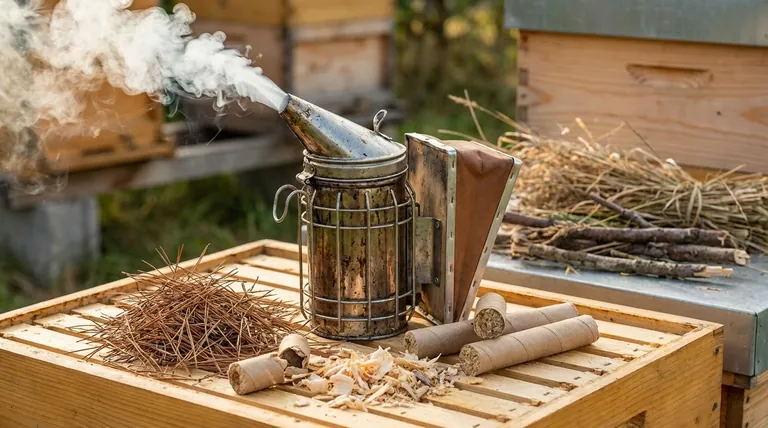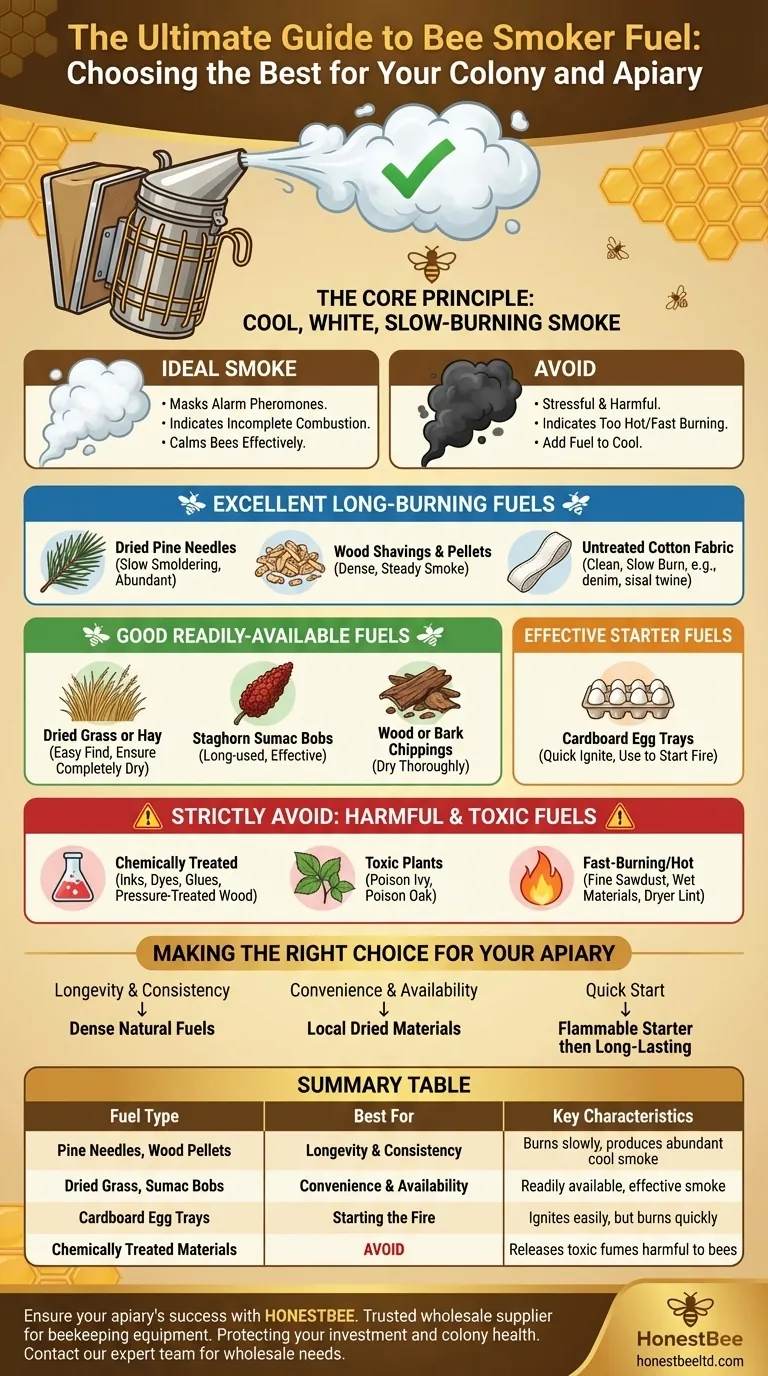The best fuel for a bee smoker is not a single material, but any natural, untreated substance that burns slowly and produces abundant, cool, white smoke. Highly effective and popular options include dried pine needles, wood shavings, untreated cotton fabric, or even pellet-stove fuel. The primary goal is to select a fuel that smolders consistently without burning too hot or releasing chemicals that could harm the bees.
The quality of your smoker fuel is defined by its output, not its specific type. Your goal is to create a cool, gentle smoke that calms the bees, which requires a fuel that smolders consistently without producing excessive heat or harmful chemicals.

The Principles of an Ideal Smoker Fuel
To choose the right fuel, you must first understand what you are trying to achieve. The smoke is a tool to mask alarm pheromones, not an irritant to drive the bees away.
Produces Cool, White Smoke
The ideal output is a thick, cool, and white smoke. This indicates incomplete combustion, which is what you want.
If you see dark or black smoke, it means the fuel is burning too hot. This hot smoke is stressful and harmful to the bees, and it's a clear sign that you need to add more fuel to cool the burn.
Burns Slowly and Consistently
A good fuel should smolder for a long time. This allows you to complete a full hive inspection without the smoker going out, which can be a significant inconvenience.
Fuels that burn too quickly require constant attention and refilling.
Is Completely Non-Toxic
The safety of your bees is paramount. Your fuel must be free of chemicals, pesticides, glues, inks, and other contaminants.
Always use natural, untreated materials. If you are unsure if a material has been treated, it is best to avoid it.
Evaluating Common Fuel Sources
The "best" fuel is often what is available, safe, and effective in your specific environment.
Excellent Long-Burning Fuels
These materials provide the most consistent, long-lasting, and cool smoke.
- Pine Needles: A classic choice. They are readily available in many areas, light easily, and smolder for a very long time.
- Wood Shavings or Pellets: Fuel for pellet stoves or natural wood shavings (not dense sawdust) are excellent. They are dense and produce a steady smoke.
- Untreated Cotton: Scraps of old, 100% cotton fabric (like denim jeans) or untreated sisal baling twine are superb fuels that burn slowly and cleanly.
Good Readily-Available Fuels
These are effective and often found right in your yard, but may burn slightly faster than the options above.
- Dried Grass or Hay: Easy to find and works well. Ensure it is completely dry to avoid a smoky, steamy mess.
- Staghorn Sumac Bobs: The fuzzy red seed heads of the staghorn sumac are a fantastic, long-used fuel source.
- Wood or Bark Chippings: These work well but may need to be dried thoroughly before use to ensure they smolder correctly.
Effective Starter Fuels
Some materials are great for getting the smoker lit but are not ideal for sustained use.
- Cardboard Egg Trays: These catch fire easily and produce a lot of initial smoke. However, they burn out very quickly and are best used only to start the fire before adding a longer-burning fuel on top.
Fuels and Materials to Strictly Avoid
Using the wrong fuel can be ineffective at best and harmful to your colony at worst.
Chemically Treated Materials
Never use paper with heavy inks, glossy cardboard, dryer lint (which contains synthetic fibers), or any wood that has been painted, stained, or pressure-treated. These can release toxic fumes.
Fast-Burning or Hot Fuels
While dry grass mowings can work, they can also burn up very quickly and produce hot smoke if not packed properly. Very fine, dense sawdust should also be avoided as it can inhibit airflow or burn too hot.
Toxic Plants
Be absolutely certain of your plant identification. Never use poison ivy, poison oak, or any other toxic plant matter, as the smoke can be harmful to both you and your bees.
Making the Right Choice for Your Apiary
Your ideal fuel balances performance with practical availability. Experiment with safe, natural materials to find what works best for you.
- If your primary focus is longevity and consistency: Choose dense, natural fuels like wood pellets, shavings, or tightly packed pine needles.
- If your primary focus is convenience and availability: Use locally sourced, dried materials like untreated grass, hay, or staghorn sumac bobs.
- If you need to get the smoker started quickly: Begin with a flammable but fast-burning material like a cardboard egg tray before adding longer-lasting fuel on top.
Ultimately, observing your smoke's quality and your bees' reaction is the best way to validate your fuel choice.
Summary Table:
| Fuel Type | Best For | Key Characteristics |
|---|---|---|
| Pine Needles, Wood Pellets | Longevity & Consistency | Burns slowly, produces abundant cool smoke |
| Dried Grass, Sumac Bobs | Convenience & Availability | Readily available, effective smoke |
| Cardboard Egg Trays | Starting the Fire | Ignites easily, but burns quickly |
| Chemically Treated Materials | AVOID | Releases toxic fumes harmful to bees |
Ensure your apiary's success with the right supplies from HONESTBEE.
As a trusted wholesale supplier for commercial apiaries and beekeeping equipment distributors, we provide the high-quality, reliable equipment you need to operate efficiently and safely. The right tools, like a well-functioning smoker, are fundamental to protecting your investment and ensuring colony health.
Let HONESTBEE be your partner in productivity. Contact our expert team today to discuss your wholesale needs and discover how our beekeeping supplies can support your business's growth.
Visual Guide

Related Products
- 54-Piece Smoker Fuel Pellets for Beekeeping Beehive Smoker Fuel
- Professional Bee Smoker with Elongated Spout and Durable Bellows for Beekeeping
- Economy Galvanized Beekeeping Honey Bee Smoker for Wholesale
- Premium Traditional Copper Bee Smoker with Bellows
- Stainless Steel Honey Bee Smoker Hive and Honeycomb Smoker for Beekeeping
People Also Ask
- What is the importance of fuel in a bee smoker? Ensure Cool, Calming Smoke for Your Hive
- What is best to burn in a bee smoker? Master the Layered Fuel Technique for Calm Hives
- What is the best material for a bee smoker? Choose the Right Fuel for a Calm Hive
- What can I use for bee smoker fuel? Choose Safe, Natural Materials for a Calm Hive
- What are important considerations when choosing smoker fuel? A Guide to Safe, Effective Beekeeping



















